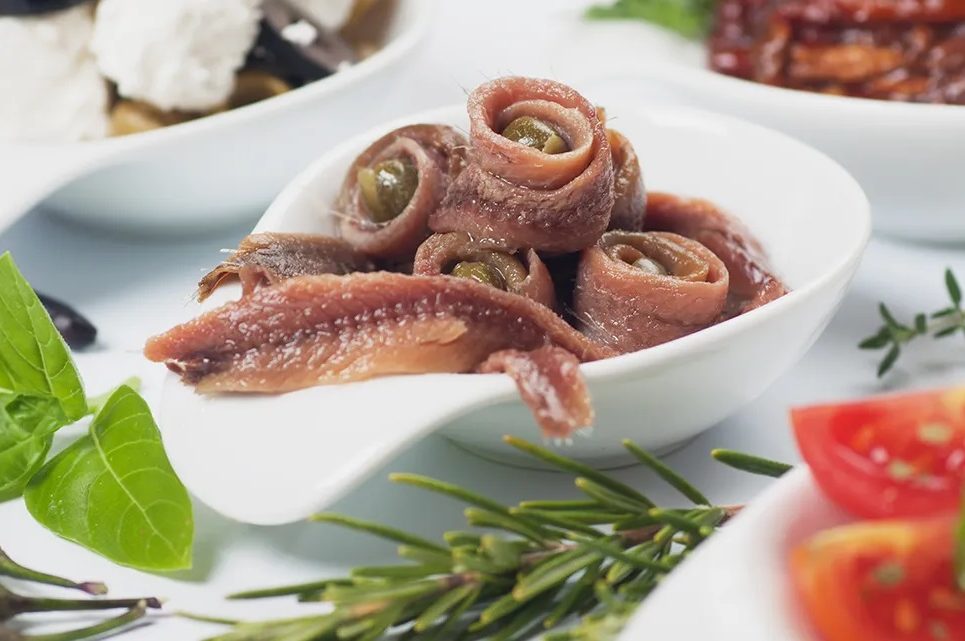We are blessed to be living in a golden age of anchovies. They’re everywhere — lacing salads, festooning pizzas, draped across inordinately expensive small plates. In certain circles, there are few more potent social signifiers than the red, yellow and blue of an Ortiz tin. Victory for the umami junkies.
How times change. Today the average Spaniard puts away six pounds of the things each year, but it was a different story in the sixteenth century, when the Catalan chef Ruperto de Nola complained that anchovies were “commonly bitter.” A little later, the English physician Tobias Venner fumed that they “do nourish nothing at all, but a naughty cholerick blood.”
These denunciations are quoted by Christopher Beckman, an archaeological researcher and former horror-film producer, in his sweeping, data-laden study (A Twist in the Tail) of the anchovy’s mixed fortunes in the western world. Though “highly valued as a flavor enhancer” in their various forms — salted, pickled, tinned in oil — they have also been routinely traduced as a “worthless little fish.”
It isn’t news that foods go in and out of fashion. Think of Dr. Johnson trundling to the market in Georgian London to buy dirt-cheap oysters for his cat. But Beckman argues, convincingly, that anchovies are a special case. Over six chunky chapters, each focusing on a particular country (or empire), he shows how their shifting status has reflected wider changes in food, culture, trade and even medicine.
We begin in ancient Rome, with garum. Although recipes varied for this fermented fish sauce (funky enough that it could still be smelt on amphorae retrieved from Pompeii), it’s clear that anchovies were often part of the mix. Garum was big business, with factories churning it out across the empire, and it straddled the social classes. For the poet Martial, it was a guilty pleasure, both “noble” and “putrid.” Alas, the barbarians, with their beer and lard, had no time for it. So it was exiled — and anchovies with it.
Only during the later medieval period did they begin to rally, aided by demand in Europe for salted herring (a not especially nice substitute for meat on Fridays). In Italy, people mostly embraced them as fast as you can say bagna cauda, though the doctor Giovanni Filippo Ingrassia cautioned against eating too many, “as the poor usually do.”
The French proved more capricious. Anchovies paired with butter — newly permissible after cooks stopped having to worry about the four humors — became a fixture of seventeenth century haute cuisine, but were subsequently jettisoned by the chef Antonin Carême and his mother-sauce-worshipping cronies. The Spanish, despite a ready supply in their waters, appeared to suffer cultural cringe, spurning anchovies until the twentieth century (apart from in Andalusia, where they have long been deep fried). But they made up for lost time, and Beckman has some interesting theories about the evolution of tapas — including the now ubiquitous gilda.
My favorite chapter was “The British Anchovy.” The first written use of the word came in Shakespeare’s Henry IV, Part I, establishing the fish as a snack for boozers. Rummaging through the pockets of a sozzled Falstaff, Prince Hal and Peto find a receipt: “Anchovies and sack after supper, 2s 6d.” Samuel Pepys, we discover, also had a weakness for “drinking wine and eating anchovies an hour or two.” Later, amid the nineteenth century craze for condiments, a mad old sod called Dr. William Kitchiner (supposedly the inventor of crisps) provided a recipe for “Tomata Catsup” featuring large quantities of anchovies — and brandy. “It will keep for seven years.”
Beckman is a likable guide, and there’s no doubting his zeal for the subject. Some may feel, when he refers to the debates “raging” in anchovy studies, that he overstates his case. Not me. Reading A Twist in the Tail, I found myself anxious to know how the Renaissance, say, or the rise of Mussolini, would affect anchovies. Beckman seems almost personally affronted when someone fails to treat his fish with the respect it deserves, and we encounter a motley cast of villains, including Mrs. Beeton. (Nigella Lawson, a longstanding champion of the “bacon of the sea,” is rightly venerated.)
Still, this could — should — have been a better book. The problem is the prose, which can be alarmingly wayward. It starts small — odd instances where Beckman’s editors appear to have let him down. Surely someone could have suggested a more elegant phrase than the Dan Quayle-esque “taking a happy turn for the better,” or discreetly subtracted a word from the description of Seneca as a “noted Stoic philosopher.” But infelicities accumulate. Sentences are clogged by qualifiers (“But perhaps in his younger days, prior to being favored by the gods, he might have…”) and dangling participles come in shoals (“Like many young boys fending for themselves in the city, hunger was his constant companion…”) And even if Will Self has given the thesaurus a bad name, Beckman could have used one to find a few more words for “astonishing.”
Enough! Prose matters, but Beckman’s book remains a labor of love, intriguing and impressively researched. Now bring me my anchovies and wine.
This article was originally published in The Spectator’s UK magazine. Subscribe to the World edition here.

























